
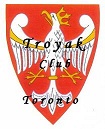
HAPPY NEW YEAR 2022
BONNE ANNÉE 2022

SZCZĘŚLIWEGO NOWEGO ROKU 2022
FELIZ AÑO NUEVO 2022

TROYAK EXECUTIVE TEAM is informing all members, colleagues, collectors, and Polonia at large, that Club meetings taking place at John Paul II Polish Cultural Centre, 4300 Cawthra Rd. (just south of Hwy. 403), Mississauga, Ontario. The new members are always welcome. www.polishculturalcentre.ca
ADRES SPOTKAÑ KLUBOWYCH ! Zarząd Główny Klubu “Troyak” informuje wszystkich członków kolekcjonerów, sympatyków oraz całą Polonię, że spotkania klubowe odbywają się w Polskim Centrum Kultury im. Jana Pawła II, przy 4300 Cawthra Rd. (na południe od autostrady 403), Mississauga, Ontario. Zapraszamy nowych członków do prężnego. Klubu “Troyak”. www.polishculturalcentre.ca

“TROYAK” CLUB NEXT MEETINGS …
NASTĘPNE SPOTKANIA KLUBU “TROYAK” …
16th January 2022 @ 4:30 p.m. …
… Annual General Meeting … via ZOOM only!
30th January 2022 @ 4:30 p.m. … via ZOOM only!
27th February 2022 … via ZOOM
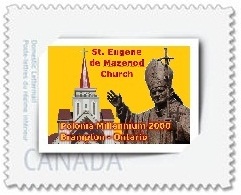
Sunday – 6th March 2022 @ 9:00 a.m. to 4:00 p.m.
Mississauga Coin & Stamp Show
27th March 2022 @ 4:30 p.m.
24th April 2022; 29th May 2022; 26th June 2022

July & August 2022 – Summer break … Letnie wakacje …
25th September 2022
Sunday – 2nd October 2022 @ 9:00 a.m. to 4:00 p.m.
Mississauga Coin & Stamp Show
30th October 2022
27th November 2022
December 2022 … Happy Holidays


Wystawa Światowa EXPO 2020 w Dubaju
EXPO 2020 Dubai
www.poczta-polska.pl
W dniu 1 października 2021 r. został wprowadzony do obiegu znaczek pocztowy o wartości 8,00 zł, emisji “Wystawa Światowa EXPO 2020 w Dubaju”. Na znaczku i kopercie FDC przedstawiono wizualizację Pawilonu Polski. Polska znalazła się w ekskluzywnym gronie kilkudziesięciu krajów, które budują własny pawilon na Wystawie Światowej EXPO 2020 w Dubaju. Pawilon Polski jest główną areną prezentacji oraz nośnikiem informacji o Polsce. Autorem projektu oraz koncepcji architektoniczno-tematycznej jest warszawska pracownia WXCA.
Architektura Pawilonu odnosi się w sposób czytelny do hasła mobilności. Tworzy otwartą, rozrastającą się ku górze, modułową konstrukcję, która zaprasza odwiedzających do odpoczynku w cieniu rozłożystego zadaszenia i kontemplacji unoszącej się ponad głowami gości instalacji – rzeźby kinetycznej wyobrażającej lecące stado ptaków. Na datowniku okolicznościowym zaprezentowano: trójkąty, motywy rzeźby kinetycznej Pawilonu. Projekt został zrealizowany w ścisłej współpracy z wnioskodawcą, Polską Agencją Inwestycji i Handlu. Znaczek wydrukowano techniką offsetową, na papierze fluorescencyjnym, w formacie: format znaczka: 31,25 x 43 mm, format bloku: 70 x 90 mm , w nakładzie 78 000 sztuk. Z tej okazji została wydana również koperta FDC. Autor projektu znaczka: Jan Konarzewski.
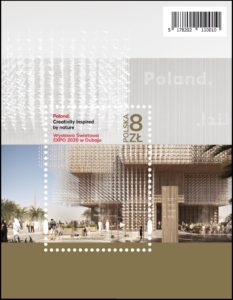
EXPO 2020 Dubai … denomination: 8,00 PLN;
number of stamps in set: 1; print run: 78 000 pcs;
printing techniques: offset; paper: fluorescent;
stamp size: 31,25 x 43 mm, block size: 70 x 90 mm;
number of FDC: 1; author: Jan Konarzewski;
circulation date: 1st October 2021.
To kolejne wydawnictwo filatelistyczne promujące Światową Wystawę. W 2015 roku do obiegu trafił walor dedykowany EXPO w Mediolanie, natomiast w roku 2017 Spółka oddała w ręce Klientów i filatelistów znaczek poświęcony Wystawie w Astanie.
Przypomnijmy, że historia Światowych Wystaw (EXPO) sięga 1751 roku, kiedy to w Londynie odbyło się pierwsze tego typu wydarzenie. Jednak prawdziwie międzynarodowe przedsięwzięcie zainicjowane zostało podczas Wielkiej Wystawy z 1851 roku, która również miała miejsce w Londynie. EXPO do dziś to cykliczne wydarzenia prezentujące dorobek kulturalny, naukowy oraz techniczny krajów i narodów świata. Jest ono doskonałą okazją do współzawodnictwa we wszystkich dziedzinach produkcji. Już w roku 1889, specjalnie na paryską wystawę światową, zbudowano wieżę Eiffla, która miała zademonstrować poziom wiedzy inżynierskiej i możliwości techniczne epoki. Organizatorzy kolejnych imprez dążą do prześcignięcia poprzednich, m.in. w dziedzinie rozwiązań technicznych i architektonicznych, czy rozmachu uroczystości oficjalnych. Projekt znaczka został zrealizowany przez Pocztę Polską w ścisłej współpracy z wnioskodawcą, Polską Agencją Inwestycji i Handlu.

XVIII Międzynarodowy Konkurs Pianistyczny im. Fryderyka Chopina
18th International Fryderyk Chopin Piano Competition
www.poczta-polska.pl
W dniu 2 października 2021 r. została wprowadzona do obiegu kartka pocztowa z nadrukowanym znakiem opłaty pocztowej, emisji: XVIII Międzynarodowy Konkurs Pianistyczny im. Fryderyka Chopina. Wartość nominalna znaku opłaty pocztowej z oznaczeniem literowym A odpowiada wartości nominalnej znaczka pocztowego używanego do uiszczenia opłaty za ekonomiczną przesyłkę listową nierejestrowaną, w tym kartkę pocztową, w obrocie krajowym, w formacie S o masie do 500 g. W prawym górnym rogu strony adresowej kartki nadrukowano znak opłaty pocztowej, na którym umieszczono tegoroczne logo konkursu. W prawym dolnym rogu znaczka umieszczono oznaczenie wartości: A, a wzdłuż górnej krawędzi napis: POLSKA.
W części ilustracyjnej kartki znajduje się akwarela Fryderyka Chopina wg. popiersia W. Szymanowskiego, autorstwa Andrzeja Gosika oraz tytuł emisji ,,XVIII Międzynarodowy Konkurs Pianistyczny im. Fryderyka Chopina”. Kartkę o wymiarach 148 x 105 mm wydrukowano jednostronnie, techniką offsetową, na kartonie białym, w nakładzie 8000 sztuk. Autor projektu kartki: Andrzej Gosik.

18th International Fryderyk Chopin Piano Competition …
denomination: 3,30 PLN; number of stationeries in set: 1;
print run: 8.000 pcs; printing technique: offset;
card size: 148 x 105 mm; author: Andrzej Gosik;
release date: 2nd October 2021.

Caritas Polska
Caritas Poland
www.poczta-polska.pl
W dniu 6 października 2021 r. został wprowadzony do obiegu znaczek pocztowy o wartości 10,00 zł emisji “Caritas Polska”. Na znaczku zaprezentowano logo 30 lat Caritas Polska. Wzdłuż dolnej krawędzi umieszczono napis: POLSKA i oznaczenie wartości: 10 zł. Na kopercie zaprezentowany został obraz Miłosiernego Samarytanina. Znaczek wydrukowano techniką rotograwiurową, na papierze fluorescencyjnym, w formacie 25,5 x 31,25 mm, w nakładzie 2 000 000 sztuk. Arkusz sprzedażny zawiera 100 szt. znaczków. Z tej okazji została wydana również koperta FDC. Autor projektu: Jacek Konarzewski.
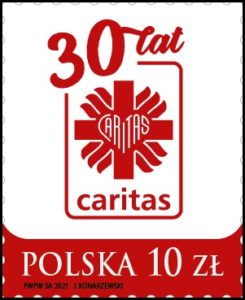
Caritas Poland … denomination: 10,00 PLN;
number of stamps in set: 1 (100 pcs in sheet);
print run: 2 000 000 pcs.; printing techniques: photogravure;
paper: fluorescent; stamp size: : 25,5 x 31,25 mm;
number of FDC: 1; author: Jacek Konarzewski;
circulation date: 6th October 2021.
Znaczek przygotowany został przez projektanta Jacka Konarzewskiego w prostej formie. Przedstawia jubileuszowe logo katolickiej organizacji charytatywnej Konferencji Episkopatu Polski z dominującym czerwonym krzyżem i informacją o 30 latach jej działania. Wzdłuż dolnej krawędzi umieszczono napis: POLSKA wraz z oznaczeniem wartości: 10 zł. Uroczysta prezentacja waloru filatelistycznego, który został przez Pocztę Polską wzbogacony o atrakcyjną wizualnie kopertę z obrazem Miłosiernego Samarytanina i datownik okolicznościowy odbyła się 6 października w Warszawie.

100. Rocznica urodzin Tadeusza Różewicza
100th Anniversary of the Birth of Tadeusz Różewicz
www.poczta-polska.pl
W dniu 9 października 2021 r. została wprowadzona do obiegu kartka pocztowa z nadrukowanym znakiem opłaty pocztowej, emisji: 100. rocznica urodzin Tadeusza Różewicza. Tadeusz Różewicz (ur. 9 października 1921w Radomsku, zm. 24 kwietnia 2014 we Wrocławiu) – polski poeta, dramaturg, prozaik i scenarzysta, członek Wydziału VI Twórczości Artystycznej Polskiej Akademii Umiejętności. Wartość nominalna znaku opłaty pocztowej z oznaczeniem literowym A odpowiada wartości nominalnej znaczka pocztowego używanego do uiszczenia opłaty za ekonomiczną przesyłkę listową nierejestrowaną, w tym kartkę pocztową, w obrocie krajowym, w formacie S o masie do 500 g.
W prawym górnym rogu strony adresowej kartki nadrukowano znak opłaty pocztowej, na którym umieszczono zdjęcie Tadeusza Różewicza autorstwa Adama Hawałeja. Wzdłuż prawej krawędzi znaczka umieszczono napis: POLSKA i oznaczenie wartości: A. W części ilustracyjnej kartki znajduje się fotografia Tadeusza Różewicza z trakcie spaceru, autorstwa Adama Hawałeja, fragment rękopisu Tadeusza Różewicza oraz tytuł emisji ,,100. rocznica urodzin Tadeusza Różewicza”. Kartkę o wymiarach 148 x 105 mm wydrukowano jednostronnie, techniką offsetową, na kartonie białym, w nakładzie 8000 sztuk. Autor projektu kartki: Jarosław Ochendzan.
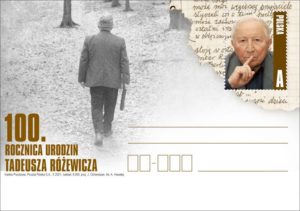
100th Anniversary of the Birth of Tadeusz Różewicz …
denomination: 3,30 PLN; number of stationeries in set: 1;
print run: 8.000 pcs; printing technique: offset;
card size: 148 x 105 mm; author: Jarosław Ochendzan;
release date: 9th October 2021.

25 lat Polski w OECD
25 years of Poland in the OECD
www.poczta-polska.pl
W roku 2021 obchodziliśmy jubileusz 25-lecia polskiego członkostwa w OECD. Z tej okazji Ministerstwo Rozwoju i Technologii wystąpiło z inicjatywą wydania przez Pocztę Polską znaczka okolicznościowego „25 lat Polski w OECD”. W jego oficjalnej prezentacji uczestniczyli wiceszef MRiT Grzegorz Piechowiak oraz Tomasz Zdzikot, prezes Poczty Polskiej i Wiesław Włodek, wiceprezes Spółki.
– Organizacja Współpracy Gospodarczej i Rozwoju już od 60 lat wyznacza standardy regulacji i prawa gospodarczego na świecie. Była też pierwszym ugrupowaniem świata zachodniego, do którego nasz kraj został zaproszony i przyjęty po zmianach ustrojowych 1989 roku. Trwająca ćwierć wieku współpraca przyniosła wiele korzyści polskiej gospodarce i społeczeństwu. Z tej okazji, wśród licznych działań promocyjno-informacyjnych, wydaliśmy również okolicznościowy znaczek – powiedział wiceminister rozwoju i technologii Grzegorz Piechowiak.
– Kiedy 25 lat temu Polska na równych prawach przystąpiła do Organizacji Współpracy Gospodarczej i Rozwoju – OECD – de facto powróciła do grupy państw Zachodu. Od tego wydarzenia rozpoczęła się nasza droga do struktur NATO i Unii Europejskiej. Jubileusz tamtego wydarzenia uczciliśmy znaczkiem symbolizującym wspólne dążenie członków OECD do jak najwyższego poziomu wzrostu gospodarczego i stopy życiowej obywateli, zgodnie z głównym celem przyświecającym tej organizacji – powiedział Tomasz Zdzikot, prezes zarządu Poczty Polskiej.
Emisja filatelistyczna okolicznościowego znaczka „25 lat Polski w OECD” stanowi część działań promocyjno-informacyjnych związanych z jubileuszowymi obchodami naszej aktywności w Organizacji Współpracy Gospodarczej i Rozwoju. W dniu 16 października 2021 r. został wprowadzony do obiegu znaczek pocztowy o wartości 3,30 zł emisji “25 lat Polski w OECD”. Na znaczku w jego górnej części umieszczono nazwę emisji ,,25 lat Polski w OECD”, w lewym górnym rogu oznaczenie wartości: 3,30 zł i napis: Polska, w środkowej części znajduje się logotyp OECD, w tle znaczka widnieją strzałki w różnych kolorach. Znaczek wydrukowano techniką rotograwiurową, na papierze fluorescencyjnym, w formacie 40,5 x 54 mm, w nakładzie 140 000 szt. Arkusz zawiera 35 szt. znaczków.

25 years of Poland in the OECD … denomination: 3,30 PLN;
number of stamps in set: 1 (35 pcs in sheet); paper: fluorescent;
print run: 140 000 pcs.; printing techniques: photogravure;
stamp size: 40,5 x 54 mm; author: Jan Konarzewski;
number of FDC: 1; circulation date: 16th October 2021.
Autor projektu, Jan Konarzewski, przedstawił na znaczku logo Organizacja Współpracy Gospodarczej i Rozwoju (OECD). W tle waloru widnieją strzałki w różnych kolorach. Oprócz znaczka Poczta Polska wydała, w limitowanej wersji, kopertę FDC, która przedstawia ona symboliczną grafikę nawiązującą do 25 lat obecności naszego kraju w OECD.
Polska została członkiem Organizacji Współpracy Gospodarczej i Rozwoju (OECD) 22 listopada 1996 r. jako pierwsze ugrupowanie świata zachodniego o charakterze integracyjnym, do którego nasz kraj został zaproszony i przyjęty po wprowadzeniu prodemokratycznych zmian ustrojowych. Obecnie do OECD należy 37 państw. Od czerwca 2021 r. jej szefem jest Australijczyk Mathias Cormann.


100. Rocznica urodzin Czesława Słani
100th Anniversary of the Birth of Czesław Słania
www.poczta-polska.pl
W dniu 22 października 2021 r. został wprowadzony do obiegu znaczek pocztowy w formie bloku o wartości 15,30 zł, emisji “100. rocznica urodzin Czesława Słani”. Projekt dedykowany 100-leciu urodzin Czesława Słani został zrealizowany w ramach emisji wspólnej Poczty Polskiej i Poczty Szwedzkiej. Wspólna koncepcja prezentuje wizerunek Czesława Słani podczas wykonywania rytu znaczka na podstawie fotografii portretowej Czesława Słani autorstwa Pera Sihlberga, szwedzkiego artystę fotografika. Projekt graficzny wykonała Marzanna Dąbrowska, zaś ryt znaczka – Przemysław Krajewski (PWPW SA). Obydwie emisje, polska i szwedzka, zostały wprowadzone do obiegu 22.10.2021 r.
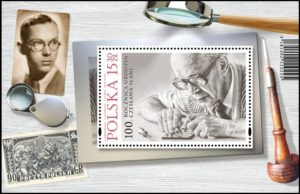
Znaczek widnieje na płytce stalorytniczej. Na oprawie bloku umieszczono: w górnym lewym rogu fotografię legitymacyjną Czesława Słani autorstwa Edwarda Hartwiga, jednego z najwybitniejszych polskich fotografików, poniżej lupkę i projekt znaczka ,,Bitwa pod Grunwaldem” – pracę dyplomową Słani, zaś w górnym prawym rogu znajduje się lupa, zaś wzdłuż prawego boku bloku – rylec. W projekcie znaczka zamieszczone są również mikroteksty, odnoszące się do zabiegów artystycznych Słani, a będące ciekawostką filatelistyczną dla kolekcjonerów.
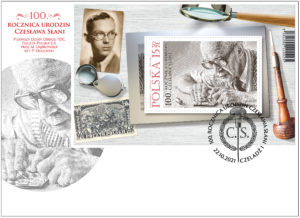
Na kopercie FDC zaprezentowano portret Czesława Słani – powiększony fragment stalorytu ze znaczka. Na datowniku zamieszczono podstawowe narzędzie pracy tj. rylec, którym mistrz Słania rytował swoje prace, oraz inicjały C.S. otoczone wieńcem liści laurowych.
Znaczek szwedzki emisji ,,100. rocznica urodzin Czesława Słani” ma zbliżony wymiar do polskiego. W płaszczyźnie projektowej, blok szwedzki różni się od polskiego kompozycją lupki i zdjęcia młodego Czesława Słani. Ponadto w miejsce tzw. ,,Grunwaldu” umieszczono tysięczny znaczek Słani ,,Wielkie czyny szwedzkich królów” na podstawie fresku Dawida Klöckera na plafonie zamku Drottningholmn z 2000 r. Ryt znaczka wykonał szwedzki rytownik Lars Sjööblom, uczeń Czesława Słani. Blok wydania szwedzkiego emisji jest dostępny w sprzedaży w Filatelistycznym Sklepie Internetowym.
Znaczek wydrukowano na papierze fluorescencyjnym następującymi technikami druku: staloryt, offset, raster stochastyczny, mikrotekst. Format znaczka: 79 x 51 mm,format bloku: 154 x 98 mm. Nakład znaczka 100 000 szt. Autor projektu: Marzanna Dąbrowska. Autor rytu: Przemysław Krajewski. Autor fotografii Czesława Słani (na znaczku): Per Sihlberg. Autor fotografii Czesława Słani (na bloku): Edward Hartwig.
Od 22.10 2021r. w Internetowym Sklepie Filatelistycznym jest dostępny również w sprzedaży folder filatelistyczny ,,100. rocznica urodzin Czesława Słani”. Wydawnictwo zawiera znaczek polski, znaczek szwedzki oraz kolorową próbę stalorytu. Dostępny nakład to jedynie 1000 sztuk. Cena wydawnictwa – 150,00 zł.
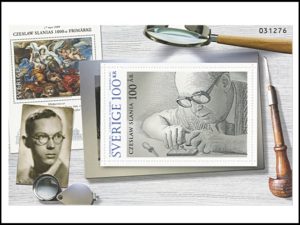
100th Anniversary of the Birth of Czesław Słania …
denomination: 15,30 PLN; number of stamps in set: 1;
print run: 100 000 pcs; paper: fluorescent;
printing techniques: offset, intaglio, stochastic raster,
microtext; stamp size: 79 x 51 mm; number of FDC: 1;
block size: 154 x 98 mm; Designer: Marzanna Dąbrowska;
Engraver: Przemysław Krajewski;
Author of photo of Czesław Słania (on stamp): Per Sihlberg;
Author of photo of Czesław Słania (on block): Edward Hartwig;
circulation date: 22nd October 2021.
From 22nd October 2021, a philately folder “100th Anniversary of the Birth of Czesław Słania” issue is available in the offer of philately on-line shop. This issue contains Polish and Swedish block and colour intaglio sample. The available edition is only 1000 pieces. Price of the issue – 150,00 PLN.

Grupa Ładosia
Ładoś Group
www.poczta-polska.pl
W dniu 23 października 2021 r. został wprowadzony do obiegu znaczek pocztowy o wartości 4,00 zł emisji “Grupa Ładosia”. Na znaczku widnieje koloryzowane artystycznie zdjęcie portretowe Aleksandra Ładosia , polskiego dyplomaty , członka i lidera nieformalnej grupy nazwanej od jego nazwiska “grupą Ładosia” lub “grupą berneńską”, która w latach 1941-1943 wystawiała fałszywe paszporty latynoamerykańskie Żydom z gett na terenie okupowanej Polski ratując ich przed zagładą.Na znaczku umieszczono również nazwiska pozostałych członków ścisłego kierownictwa Grupy, która liczyła setki osób działających w całkowitej konspiracji z narażeniem własnego życia. Na oprawie arkusika 9-znaczkowego zamieszczona została nazwa emisji, nazwiska pozostałych członków kierownictwa Grupy oraz fragmenty dokumentów ( paszportów) i zdjęć paszportowych ocalałych Żydów. Na kopercie FDC umieszczono archiwalne zdjęcia (PAP) i stemple paszportowe uzyskane dzięki życzliwości Państwowego Muzeum Auschwitz – Birkenau w Oświęcimiu.
Całość czyli znaczek, arkusik i FDC łączą fragmenty polskich, biało-czerwonych barw narodowych. W datowniku wykorzystano autentyczną pieczęć konsulatu Rep. Paragwaju ( z paszportu ocalałych). Emisja jest merytorycznie konsultowana z Instytutem Pileckiego i Muzeum Auschwitz – Birkenau w Oświęcimiu, skąd pochodzą unikalne materiały archiwalne, w tym materiał na datownik okolicznościowy, który stanowi archiwalną pieczęć z paszportu tzw.paragwajskiego (scany paszportu z tzw.Archiwum Eissa). Dzięki takim dokumentom i pieczęciom (fałszywym paszportom) ponad 3600 Żydów z tzw.listy Ładosia uniknęło zagłady. Lista ciągle jest uzupełniana dzięki dalszym badaniom historyków i archiwistów. Emisja znaczka PP wpisuje się w obchody Roku Grupy Ładosia ogłoszonego przez Sejm RP. Znaczek wydrukowano techniką offsetową, na papierze fluorescencyjnym, w formacie znaczka 31,25 x 43 mm, w nakładzie 144.000 sztuk. Arkusz zawiera 9 znaczków. Z tej okazji została wydana również koperta FDC. Autor projektu: Agnieszka Sancewicz.
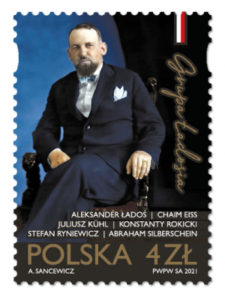
Ładoś Group … denomination: 4,00 PLN;
number of stamps in set: 1; print run: 144.000 pcs.;
printing techniques: offset; paper: fluorescent;
stamp size: 31,25 x 43 mm; 9 stamps in sheet;
number of FDC: 1; author: Agnieszka Sancewicz;
circulation date: 23th October 2021.

30. Rocznica przystąpienia Rzeczpospolitej Polskiej do Rady Europy
30th Anniversary of the Accession of the Republic of Poland
to the Council of Europe
www.poczta-polska.pl
W dniu 10 listopada 2021 r. została wprowadzona do obiegu kartka pocztowa z nadrukowanym znakiem opłaty pocztowej, emisji: 30. rocznica przystąpienia Rzeczpospolitej Polskiej do Rady Europy. Wartość nominalna znaku opłaty pocztowej z oznaczeniem literowym A odpowiada wartości nominalnej znaczka pocztowego używanego do uiszczenia opłaty za ekonomiczną przesyłkę listową nierejestrowaną, w tym kartkę pocztową, w obrocie krajowym, w formacie S o masie do 500 g.
W prawym górnym rogu strony adresowej kartki nadrukowano znak opłaty pocztowej, na którym umieszczono flagę Polski. Powyżej umieszczono napis: Polska oraz oznaczenie wartości: A. W części ilustracyjnej widnieje Pałac Europy, główny budynek Rady Europy w Strasburgu we Francji, zaś powyżej logo Rady Europy oraz napis Council of Europe i Conseil de la Europe . Poniżej umieszczony jest tytuł emisji ,,30. rocznica przystąpienia Rzeczypospolitej Polskiej do Rady Europy”. Na datowniku znajduje się logo Rady Europy. Kartka i datownik zostały zaakceptowane przez MSZ, wnioskodawców emisji oraz Radę Europy. Kartkę o wymiarach 148 x 105 mm wydrukowano jednostronnie, techniką offsetową, na kartonie białym, w nakładzie 8000 sztuk. Autor projektu kartki: Jan Konarzewski.

30th Anniversary of the Accession of the Republic of Poland
to the Council of Europe … denomination: 3,30 PLN;
number of stationeries in set: 1; print run: 8.000 pcs;
printing technique: offset; card size: 148 x 105 mm;
author: Jan Konarzewski; release date: 10th November 2021.

100. Rocznica nawiązania polsko-węgierskich stosunków dyplomatycznych
100th Anniversary of Establishing Polish-Hungarian Diplomatic Relations
www.poczta-polska.pl
W dniu 17 listopada 2021 r. została wprowadzona do obiegu kartka pocztowa z nadrukowanym znakiem opłaty pocztowej, emisji: 100. rocznica nawiązania polsko-węgierskich stosunków dyplomatycznych. Wartość nominalna znaku opłaty pocztowej z oznaczeniem literowym A odpowiada wartości nominalnej znaczka pocztowego używanego do uiszczenia opłaty za ekonomiczną przesyłkę listową nierejestrowaną, w tym kartkę pocztową, w obrocie krajowym, w formacie S o masie do 500 g.
W prawym górnym rogu strony adresowej kartki nadrukowano znak opłaty pocztowej, na którym umieszczono godło Rzeczypospolitej Polskiej i herb Republiki Węgierskiej. Poniżej umieszczono napis: POLSKA i oznaczenie wartości: A. W części ilustracyjnej kartki został przedstawiony wizerunek Zamku Królewskiego w Warszawie i Zamku Królewskiego w Budapeszcie, siedziby najwyższych władz państwowych w okresie międzywojennym obydwu państw, natomiast w tle flagi Polski i Węgier oraz tytuł emisji. Na datowniku znajduje się liczba 100, nawiązująca do rocznicy. Kartkę o wymiarach 148 x 105 mm wydrukowano jednostronnie, techniką offsetową, na kartonie białym, w nakładzie 8000 sztuk. Autor projektu kartki: Andrzej Gosik.
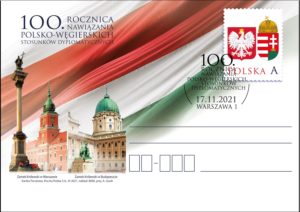
100th Anniversary of Establishing Polish-Hungarian
Diplomatic Relations … denomination: 3,30 PLN;
number of stationeries in set: 1; print run: 8.000 pcs;
printing technique: offset; card size: 148 x 105 mm;
author: Andrzej Gosik; release date: 17th November 2021.


30-lecie wznowienia działalności Caritas Polska
www.nbp.pl
Narodowy Bank Polski jest centralnym bankiem państwa odpowiadającym za politykę pieniężną i stabilność cen. Jego funkcje określa Konstytucja Rzeczypospolitej Polskiej i ustawa o NBP. NBP ma wyłączne prawo emisji pieniądza. Jako bank centralny nie prowadzi rachunków bankowych obywateli, nie przyjmuje od nich lokat, nie udziela kredytów. Prowadzi natomiast obsługę budżetu państwa, a także podmiotów sektora finansów publicznych. Gromadzi rezerwy walutowe państwa i zarządza nimi. Pełni funkcję banku banków, tworząc warunki do działania systemu bankowego. Jest również jednym z najważniejszych ośrodków naukowo-analitycznych w dziedzinie ekonomii i rynków finansowych. 6 października 2021 roku Narodowy Bank Polski wprowadził do obiegu srebrną monetę o nominale 10 zł „30-lecie wznowienia działalności Caritas Polska”.

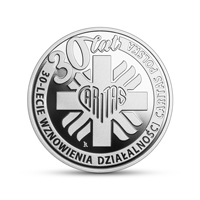
Nominał 10 zł … metal: Ag 925/1000; stempel: lustrzany; średnica: 32,00 mm; masa: 14,14 g; brzeg (bok): gładki; nakład: do 10 000 szt.; Projektant: Robert Kotowicz; Emitent: NBP; Na zlecenie NBP monetę wyprodukowała Mennica Polska S.A.
W latach 2020–2021 obchodzony jest jubileusz 30-lecia wznowienia działalności Caritas Polska. Organizacja została reaktywowana Dekretem Konferencji Episkopatu Polski z dnia 10 października 1990 roku jako instytucja czerpiąca inspiracje i wzory z działalności charytatywnej oraz społecznej prowadzonej na terenie Polski w przeszłości, przerwanej w okresie reżimu komunistycznego. Caritas Polska jest duszpasterską instytucją charytatywną Kościoła katolickiego i największą organizacją społeczno-charytatywną w Polsce. Niesie profesjonalną, wielowymiarową pomoc osobom wykluczonym i ubogim, które idą przez życie z różnego rodzaju deficytami. Będąc ich głosem i rzecznikiem, Caritas Polska odwołuje się do wyraźnie zdefiniowanych wartości ewangelicznych, które wyznaczają kryteria oceny rzeczywistości społecznej i odpowiednie zasady postępowania: dobra wspólnego, solidarności i miłości.
Działania Caritas Polska skupiają się na osobach potrzebujących, do których kierowana jest pomoc materialna, psychologiczna i duchowa. W sposób szczególny organizacja ta wspiera rodziny, dzieci i młodzież, seniorów, osoby z niepełnosprawnościami, bezdomnych, uzależnionych, opuszczających zakłady penitencjarne, migrantów i uchodźców. Ponadto Caritas Polska działa w obszarze edukacji i podnoszenia świadomości społecznej oraz świadczy pomoc humanitarną i rozwojową na wszystkich kontynentach. Reprezentuje także 45 diecezjalnych ośrodków Caritas znajdujących się na terenie Polski, wspierając je w wykonywaniu zadań. Caritas Polska jest członkiem konfederacji Caritas Internationalis i Caritas Europa, współpracuje również z watykańską Dykasterią ds. Integralnego Rozwoju Człowieka. Awers monety przedstawia miłosiernego Samarytanina udzielającego pomocy napadniętemu i rannemu wędrowcowi oraz cytat z Ewangelii św. Mateusza (Mt 7,20) w polskiej i łacińskiej wersji językowej. Na rewersie monety zaprezentowano jubileuszowy logotyp Caritas Polska oraz napis informujący o 30. rocznicy wznowienia działalności przez tę instytucję. Informacja: dr Urszula Bejma.

30th Anniversary of the Reactivation of Caritas Poland
www.nbp.pl
Narodowy Bank Polski is the central bank of the State, responsible for its monetary policy and price stability. The Bank’s functions are described in the Constitution of the Republic of Poland and the Act on NBP. NBP holds the exclusive right to issue the currency of the Republic of Poland. As the central bank, it does not provide accounts for the general public, accept deposits from or extend loans to individuals. It acts as a banker to the State budget and public sector entities. NBP also holds and manages the foreign exchange reserves of the State. Finally, it functions as a banker to banks, creating conditions for the operation of the Polish banking system. Narodowy Bank Polski is one of the most important research and analytical centres in the fields of economics and financial markets. On 6 October 2021, Narodowy Bank Polski issued into circulation a silver coin “30th Anniversary of the Reactivation of Caritas Poland”, with a face value of 10 złoty.


Face value: 10 zł … Metal: Ag 925/1000; Finish: proof; Diameter: 32.00 mm; Weight: 14.14 g; Edge (side): plain; Mintage: up to 10,000 pcs; Designer: Robert Kotowicz; Issuer: NBP; The coins, commissioned by NBP, were struck by Mennica Polska S.A.
In 2020–2021, we are celebrating the 30th anniversary of the reactivation of Caritas Poland. The organisation was reactivated pursuant to the Decree of the Polish Episcopal Conference of 10 October 1990 as an institution drawing inspiration from the charitable and social activities conducted in Poland in the past, which were interrupted during the reign of the Communist regime. Caritas Poland is a pastoral charitable institution of the Catholic Church and the largest social welfare and charitable organisation in Poland. It provides professional, multidimensional aid to people who suffer from exclusion and poverty and go through life with various sorts of deficits. Acting as their voice and advocate, Caritas Poland draws on the clearly defined values of the Gospel, which determine the criteria used to assess social reality as well as the principles of proper conduct: the common good, solidarity, and love.
The activities of Caritas Poland are focused on people in need, who are provided with material, psychological, and spiritual help. The organisation particularly supports families, children and adolescents, seniors, disabled people, the homeless, people suffering from addictions, prison leavers, migrants, and refugees. Additionally, Caritas Poland is active in the field of education and raising public awareness, and also provides humanitarian and developmental aid on all continents. The organisation also represents 45 diocesan Caritas centres located throughout Poland, supporting them in the performance of their tasks. Caritas Poland is a member of the Caritas Internationalis and Caritas Europa confederations, and also cooperates with the Vatican-based Dicastery for Promoting Integral Human Development. The obverse of the coin carries a depiction of the Good Samaritan helping the attacked and wounded traveller and a quote from the Gospel of St Matthew (Mt 7:20) in the Polish and Latin language versions. The reverse of the coin features the jubilee logotype of Caritas Poland and an inscription announcing the 30th anniversary of the institution’s reactivation. Info: Urszula Bejma, PhD.

30-lecie pierwszych wolnych wyborów parlamentarnych
www.nbp.pl
Narodowy Bank Polski jest centralnym bankiem państwa odpowiadającym za politykę pieniężną i stabilność cen. Jego funkcje określa Konstytucja Rzeczypospolitej Polskiej i ustawa o NBP. NBP ma wyłączne prawo emisji pieniądza. Jako bank centralny nie prowadzi rachunków bankowych obywateli, nie przyjmuje od nich lokat, nie udziela kredytów. Prowadzi natomiast obsługę budżetu państwa, a także podmiotów sektora finansów publicznych. Gromadzi rezerwy walutowe państwa i zarządza nimi. Pełni funkcję banku banków, tworząc warunki do działania systemu bankowego. Jest również jednym z najważniejszych ośrodków naukowo-analitycznych w dziedzinie ekonomii i rynków finansowych. 21 października 2021 roku Narodowy Bank Polski wprowadził do obiegu srebrną monetę o nominale 10 zł „30-lecie pierwszych wolnych wyborów parlamentarnych”.
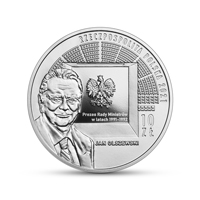
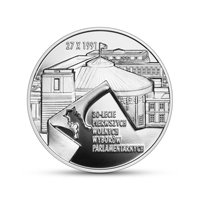
Nominał 10 zł … metal: Ag 999/1000; stempel: lustrzany; średnica: 32,00 mm; masa: 31,10 g; brzeg (bok): gładki; nakład: do 12 000 szt.; Projektant: Dominika Karpińska-Kopiec; Emitent: NBP; Na zlecenie NBP monety wyprodukowała Mennica Polska S.A. Portret Jana Olszewskiego według zdjęć autorstwa Macieja Chojnowskiego.
Polska była ostatnim państwem Europy Środkowej, w którym po upadku rządów komunistycznych doszło do wolnych wyborów parlamentarnych. Wpływ na to miał ewolucyjny charakter zmian ustrojowych, zapoczątkowanych obradami okrągłego stołu, a następnie polityka rządu Tadeusza Mazowieckiego, który postanowił przeprowadzić w pierwszej kolejności demokratyczne wybory samorządowe (maj 1990). Później zaś pogrążona w coraz ostrzejszym sporze politycznym elita ruchu „Solidarności” zdecydowała o rozpisaniu powszechnych wyborów prezydenckich. Ich zwycięzca, Lech Wałęsa, wszedł w wielomiesięczny spór z większością sejmu kontraktowego na temat kształtu ordynacji wyborczej. Wszystko to sprawiło, że wolne wybory do Sejmu przeprowadzono dopiero 27 października 1991 r.
Uczestniczyło w nich jedynie 43,2% uprawnionych, do czego przyczyniło się rozczarowanie wielu obywateli kierunkiem przemian politycznych i gospodarczych zapoczątkowanych w 1989 r. Ponieważ proporcjonalna ordynacja nie przewidywała progu wyborczego, w Sejmie znaleźli się przedstawiciele aż 24 ugrupowań, z których największą liczbą posłów (zaledwie 62) dysponowała Unia Demokratyczna. Skalę rozdrobnienia politycznego w tych wyborach do Sejmu dobrze też ilustruje fakt, że czternaście partii zdobyło mniej niż dziesięć mandatów, z czego siedem – zaledwie po jednym. Na marszałka sejmu został wybrany lider Zjednoczenia Chrześcijańsko-Narodowego prof. Wiesław Chrzanowski. Sejm I kadencji powołał w grudniu 1991 r. rząd Jana Olszewskiego, a po jego upadku, przyspieszonym przez kryzys lustracyjny (4 czerwca 1992 r.), i nieudanej misji Waldemara Pawlaka – w lipcu 1992 r. rząd Hanny Suchockiej. Udzielenie wotum nieufności temu ostatniemu gabinetowi w maju 1993 r. skłoniło prezydenta Wałęsę do rozwiązania parlamentu i rozpisania przedterminowych wyborów. Najważniejszym dokonaniem Sejmu I kadencji było uchwalenie tzw. małej konstytucji, która weszła w życie 17 października 1992 r.
Na awersie monety znajdują się portret Prezesa Rady Ministrów w latach 1991–1992 Jana Olszewskiego, fragment schematu miejsc w sali posiedzeń Sejmu oraz stylizowana urna wyborcza. Na rewersie zostały przedstawione fragment kompleksu zabudowań sejmowych z centralnie umieszczonym budynkiem mieszczącym sale posiedzeń Sejmu oraz fragment budynku Senatu. Na pierwszym planie umieszczono stylizowany fragment karty wyborczej z orłem Państwowej Komisji Wyborczej. Informacja: Antoni Dudek.

30th Anniversary of the First Free Parliamentary Election
www.nbp.pl
Narodowy Bank Polski is the central bank of the State, responsible for its monetary policy and price stability. The Bank’s functions are described in the Constitution of the Republic of Poland and the Act on NBP. NBP holds the exclusive right to issue the currency of the Republic of Poland. As the central bank, it does not provide accounts for the general public, accept deposits from or extend loans to individuals. It acts as a banker to the State budget and public sector entities. NBP also holds and manages the foreign exchange reserves of the State. Finally, it functions as a banker to banks, creating conditions for the operation of the Polish banking system. Narodowy Bank Polski is one of the most important research and analytical centres in the fields of economics and financial markets. On 21 October 2021, Narodowy Bank Polski issued into circulation a silver coin “30th Anniversary of the First Free Parliamentary Election”, with a face value of 10 złoty.


Face value: 10 zł … Metal: Ag 999/1000; Finish: proof; Diameter: 32.00 mm; Weight: 31.10 g; Edge (side): plain; Mintage: up to 12,000 pcs.; Designer: Dominika Karpińska-Kopiec; Issuer: NBP; The coins, commissioned by NBP, were struck by Mennica Polska S.A. The portrait of Jan Olszewski was designed based on the photographs by Maciej Chojnowski.
Poland was the last Central European country to hold a free parliamentary election after the fall of communist governments. This was due to the evolutionary nature of the changes in the political system initiated by the Round Table talks and then to the policy pursued by the government headed by Tadeusz Mazowiecki, who decided to hold democratic local government elections in the first place (May 1990). And later, the elite of the “Solidarity” movement, embroiled in an increasingly fierce political dispute, decided to call a general presidential election. Its winner, Lech Wałęsa, engaged in a months-long dispute with the majority of the Contract Sejm over the structure of the electoral law. It all led to the free parliamentary election taking place as late as 27 October 1991. Voter turnout at the election was only 43.2%, which was due to the discontent among many Polish citizens with the direction of the political and economic changes launched in 1989.
Since the proportional representation electoral system did not provide for an electoral threshold, the seats in the Sejm were divided amongst representatives of as many as 24 parties. Most of the seats (barely 62) were gained by the Democratic Union (Unia Demokratyczna). The degree of political fragmentation at the election is also well illustrated by the fact that 14 parties won fewer than 10 seats, with 7 of the parties gaining just 1 seat each. The leader of the Christian National Union (Zjednoczenie Chrześcijańsko-Narodowe) Prof. Wiesław Chrzanowski was elected Speaker of the Sejm.
In December 1991, the Sejm of the first term appointed a government headed by Jan Olszewski. After its fall – accelerated by the lustration crisis (4 June 1992) and followed by Waldemar Pawlak’s unsuccessful mission to form a cabinet – the government of Hanna Suchocka was formed in July 1992. The vote of no confidence in the latter, taken in May 1993, prompted President Wałęsa to dissolve the parliament and call an early election. The most significant achievement of the Sejm of the first term was the adoption of the so-called Small Constitution, which was ratified on 17 October 1992. The obverse of the coin carries a portrait of Jan Olszewski, Prime Minister in the years 1991–1992, a fragment of the seating chart for the Sejm meeting hall, and a stylised ballot box. The reverse features a fragment of the complex of the Sejm buildings, with a centrally placed building that houses the Sejm meeting halls, and a fragment of the Senate building. In the foreground, a stylised fragment of a ballot paper featuring the eagle of the National Electoral Commission is placed. Info: Antoni Dudek.

Wielcy polscy ekonomiści – Tadeusz Brzeski
www.nbp.pl
Narodowy Bank Polski jest centralnym bankiem państwa odpowiadającym za politykę pieniężną i stabilność cen. Jego funkcje określa Konstytucja Rzeczypospolitej Polskiej i ustawa o NBP. NBP ma wyłączne prawo emisji pieniądza. Jako bank centralny nie prowadzi rachunków bankowych obywateli, nie przyjmuje od nich lokat, nie udziela kredytów. Prowadzi natomiast obsługę budżetu państwa, a także podmiotów sektora finansów publicznych. Gromadzi rezerwy walutowe państwa i zarządza nimi. Pełni funkcję banku banków, tworząc warunki do działania systemu bankowego. Jest również jednym z najważniejszych ośrodków naukowo-analitycznych w dziedzinie ekonomii i rynków finansowych. 26 października 2021 roku Narodowy Bank Polski wprowadził do obiegu srebrną monetę o nominale 10 zł z serii „Wielcy polscy ekonomiści” – „Tadeusz Brzeski”.
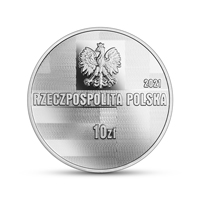

Nominał 10 zł … metal: Ag 925/1000; stempel: lustrzany; średnica: 32,00 mm; masa: 14,14 g; brzeg (bok): gładki; nakład: do 10 000 szt.; Projektant: Grzegorz Pfeifer; Emitent: NBP; Na zlecenie NBP monetę wyprodukowała Mennica Polska S.A. Wizerunek Tadeusza Brzeskiego wg zdjęcia pochodzącego ze zbiorów Narodowego Archiwum Cyfrowego. Na rewersie monety znajdują się wizerunek Tadeusza Brzeskiego, daty jego urodzin i śmierci oraz cytat pochodzący z dzieła Polska jako jednostka gospodarcza.
Tadeusz Brzeski (1884–1958) był polskim ekonomistą i nauczycielem akademickim. Studiował prawo na krakowskim Uniwersytecie Jagiellońskim oraz na Uniwersytecie Jana Kazimierza we Lwowie, jak również ekonomię na wyższych uczelniach w Monachium i Berlinie. W 1922 r. został profesorem Uniwersytetu Warszawskiego, na którym na przełomie lat dwudziestych i trzydziestych ubiegłego wieku przez jeden rok akademicki pełnił funkcję rektora. Po wybuchu II wojny światowej przeniósł się do Lwowa, skąd władze sowieckie deportowały go do Kazachstanu. Został zwolniony w 1941 r. Udało mu się wyjść wraz z armią generała Władysława Andersa na Bliski Wschód. Jeszcze w czasie wojny przeniósł się do Londynu, gdzie mieszkał do końca życia. Aktywnie uczestniczył w życiu emigracyjnym, piastując wiele ważnych stanowisk. Objął urząd rektora Polskiego Uniwersytetu na Obczyźnie, a także stanowisko prezesa Polskiego Towarzystwa Naukowego na Obczyźnie.
Tadeusz Brzeski w swojej pracy koncentrował się na zagadnieniach teoretycznych. Włożył wiele wysiłku w analizę pojęć związanych z metodologią ekonomii. Stworzył złożoną klasyfikację zjawisk gospodarczych i faktów polityki społecznej, do których zaliczał: wartości, miary i formy gospodarcze. Uczony kładł ogromny nacisk na psychologiczny aspekt życia gospodarczego. Brzeski wysunął pogląd, że teoria gospodarowania winna brać pod uwagę motywy postępowania jednostek i społeczności, co szczegółowo wyłuszczył w jednej ze swoich najważniejszych prac – Psychologicznej teorii gospodarczej w zarysie. Bronił tezy, że życie gospodarcze jest splotem faktów przyrodniczych i psychologicznych, próbując tym samym godzić argumenty szkoły historycznej z myśleniem dedukcyjnym. Wśród innych ważnych prac Brzeskiego należy wymienić następujące pozycje: O granicach ekonomii społecznej, Ekonomia. Teoria gospodarowania, Ustrój pieniężny. Teoria, Polska jako jednostka gospodarcza. Informacja: Grzegorz Jeż.

The Great Polish Economists – Tadeusz Brzeski
www.nbp.pl
Narodowy Bank Polski is the central bank of the State, responsible for its monetary policy and price stability. The Bank’s functions are described in the Constitution of the Republic of Poland and the Act on NBP. NBP holds the exclusive right to issue the currency of the Republic of Poland. As the central bank, it does not provide accounts for the general public, accept deposits from or extend loans to individuals. It acts as a banker to the State budget and public sector entities. NBP also holds and manages the foreign exchange reserves of the State. Finally, it functions as a banker to banks, creating conditions for the operation of the Polish banking system. Narodowy Bank Polski is one of the most important research and analytical centres in the fields of economics and financial markets. On 26 October 2021, Narodowy Bank Polski issued into circulation a silver coin “The Great Polish Economists” – Tadeusz Brzeski, with a face value of 10 złoty.


Face value: 10 zł … Metal: Ag 925/1000; Finish: proof; Diameter: 32.00 mm; Weight: 14.14 g; Edge (side): plain; Mintage: up to 10,000 pcs; Designer: Grzegorz Pfeifer; Issuer: NBP; The coins, commissioned by NBP, were struck by Mennica Polska S.A. The image of Tadeusz Brzeski, according to a photograph taken from the collection of the National Digital Archives. The reverse of the coin features an image of Tadeusz Brzeski, the dates of his birth and death, and a quote from the work Polska jako jednostka gospodarcza [Poland as an Economic Unit].
Tadeusz Brzeski (1884–1958) was a Polish economist and academic teacher. He studied law at the Jagiellonian University in Kraków and the Jan Kazimierz University in Lviv, as well as economics at universities in Munich and Berlin. In 1922, he became a professor at the University of Warsaw, wherein in the late 1920s and early 1930s he served as rector for one academic year. After the outbreak of World War II, he moved to Lviv, from where the Soviet authorities deported him to Kazakhstan. He was released in 1941. He managed to get out of Russia with General Władysław Anders’ army heading for the Middle East. Still during the war, he moved to London, where he lived for the rest of his life. He actively participated in emigré life, holding many important posts. He took the office of the rector of the Polish University Abroad, as well as the position of the president of the Polish Scientific Society in Exile. Tadeusz Brzeski focused on theoretical issues in his work. He put a lot of effort into the analysis of concepts related to the methodology of economics.
He created a complex classification of economic phenomena and facts of social policy, in which he included: economic values, measures and forms. The scholar placed great emphasis on the psychological aspect of economic life. Brzeski put forward the view that management theory should take into account the motives for the conduct of individuals and communities, which he elaborated in detail in one of his most important works – Psychologiczna teoria gospodarcza w zarysie [Psychological Economic Theory in Outline]. He defended the thesis that economic life is a combination of natural and psychological facts, thus trying to reconcile the arguments of the historical school with deductive thinking. Other major works by Brzeski include: O granicach ekonomii społecznej [On the Limits of Social Economy], Ekonomia. Teoria gospodarowania, Ustrój pieniężny. Teoria [Economics. Management Theory, Monetary System. Theory], Polska jako jednostka gospodarcza [Poland as an Economic Unit]. Info: Grzegorz Jeż.


Christopher Plummer: PermanentTM domestic rate stamps
www.canadapost.ca
Mark the illustrious career of Toronto-born Christopher Plummer, one of the world’s most distinguished and celebrated actors, with this booklet of 10 PermanentTM domestic rate stamps. Throughout his 70-year career, Plummer appeared in more than 200 films and television programs, performing on stages from Stratford to Broadway and receiving countless international awards and honours.
This stamp depicts Plummer in several of his most celebrated roles: Prospero in The Tempest, King Lear in King Lear, Rudyard Kipling in The Man Who Would Be King, Captain von Trapp in The Sound of Music, and John Barrymore in Barrymore. The stamp’s moody, tempestuous background is symbolic of the drama he has brought to the stage and screen.
Plummer is one of only two dozen actors to have won the coveted “triple crown of acting” awards: an Emmy, a Tony and an Oscar (Academy Award). He was a regular fixture at CBC in the 1950s, an actor in the Stratford Shakespeare Festival, and headliner at the prestigious National Theatre and the Royal Shakespeare Company. His career changed forever in 1965 when he played Captain von Trapp in The Sound of Music. Plummer’s role in the 1973 Broadway musical Cyrano earned him his first Tony Award; his second came in 1997 for his portrayal of John Barrymore. In 2009, Plummer was nominated for his first Academy Award for his performance as Leo Tolstoy in Michael Hoffman’s The Last Station. In 2011, he won his first Academy Award for his role in Beginners, becoming the oldest winner of a competitive Oscar in an acting category.

Stamp Designer: Steven Slipp; Stamp Illustrator: Spooky Pooka; Stamp; Value: Permanent™ domestic rate; Quantity Produced: 200,000; Issue Date: October 14, 2021. Good to know … PermanentTM stamps are always worth the going postage rate – no top-up stamps required, ever!

Christopher Plummer: Official First Day Cover … The moody, tempestuous background of the Official First Day Cover is symbolic of the drama Plummer brought to stage and screen. It features the stamp and its cancellation mark – Mr. Plummer’s signature. This stamp depicts Plummer in several of his most celebrated roles: Prospero in The Tempest, King Lear in King Lear, Rudyard Kipling in The Man Who Would Be King, Captain von Trapp in The Sound of Music, and John Barrymore in Barrymore. Cancellation Site: Toronto ON and Quantity Produced 8,000. Mark the illustrious career of Toronto-born Christopher Plummer, one of the world’s most distinguished and celebrated actors, with this pane of 6 PermanentTM domestic rate stamps. Quantity Produced 35,000.

2021 … Pure Silver EHR Coin – Lake Louise
www.mint.ca www.canadapost.ca
Turquoise waters, snow-capped mountains and unparalleled alpine scenery—the beauty of Lake Louise is legendary, and this pure silver coin celebrates all the geographic elements that make it one of Canada’s great treasures! Never before has the Canadian landscape been rendered so realistically as on this coin’s reverse. Its design features an overhead view of the Lake Louise area, and while Extraordinarily High Relief (EHR) technology sends the Canadian Rockies soaring to new heights, beautiful Lake Louise is unmissable thanks to coloured enamel that highlights the crown jewel of Banff National Park.

Face value: $50 dollars … Composition: 99.99% pure silver;
Mintage: 3000; Finish: proof; Weight: 82.3 g;
Diameter: 50 mm; Edge: serrated; Certificate: serialized;
Artist: Susanna Blunt (obverse).
Design: Based on elevation modelling, your coin’s reverse features Extraordinary High Relief (EHR) technology that adds height to this realistic rendering of the terrain surrounding Lake Louise in Banff National Park (Alberta), in the Canadian Rockies. Glaciers and mountain peaks are frosted to create a silvery snow-capped effect. Lake Louise is struck incuse and filled in with translucent colour enamel that mimics its famous turquoise waters. Inspired by topographic maps, contour lines form a field pattern that frames the reverse and continues on the obverse, which features the effigy of Her Majesty Queen Elizabeth II by Susanna Blunt.
“It was a thrilling experience to see Lake Louise and the surrounding terrain come to life on a coin. Working alongside our R&D staff continues to be a privilege, and with new avenues to explore, there is never a dull moment!” – Matt Eggink, Product Manager, RCM.
“Lake Louise, with its iconic turquoise waters, has captivated travellers in the Rocky Mountains since time immemorial. Today, Parks Canada welcomes visitors from around the world to take in the breathtaking glaciers and mountain landscapes, hike to incredible viewpoints, and share in the history of this unforgettable place.” – Rick Kubian, Field Unit Superintendent, Lake Louise, Yoho and Kootenay, Parks Canada.
“Using satellite mapping data, we were able to translate the geography of the Lake Louise area into a 3D model—a first for us! Despite the technical challenges of creating height and rendering the mountain range in fine detail, the final product is truly a stunning and unique representation of Canadian geography.” – Ryan Poser, Engraver.
“The Lake Louise coin is another great innovation from the Royal Canadian Mint. We can appreciate the relief’s details of the mountains around the Lake Louise area, which are located on multiple areas and non-centred on the coin, whereas for typical coins, the high relief area is centred. The maximum relief height for a typical 50mm diameter is 0.25mm while for this coin the maximum relief is more than 15 times higher! Another novelty is we were able to introduce real-life topographic satellite data in our design software in order to be able to manufacture the die as close as we can to replicate the real topography of the area on the coin.” – Yannick Cormier, Senior Research Engineer, R&D.
Did you know? … *** Beginning in late spring, Victoria Glacier’s meltwater carries silt or rock flour (fine-grained particles of rock) into Lake Louise, where these particles stay suspended in the water—in fact, the lake’s vivid colour is caused by sunlight reflecting off these particles. *** If you’re hoping to see those turquoise waters in person, you’ll want to time your visit carefully. A sunny day is best but the waters also need to have a high concentration of suspended rock flour particles. Peak time is July and August when glacial run-off is at its highest; September and early October are also good times to visit, but the colour fades as the silt settles and meltwater tapers off.

2021 … $20 Pure Silver Coin – Colourful Birds: Blue Jay
www.mint.ca www.canadapost.ca
With its blue feathers and distinguished air, the blue jay stands out wherever it goes—and it certainly does on this coin. The engraved design pairs the lively songbird with another Canadian treasure, the maple leaf, and adds selective colour to show the two at their colourful best.
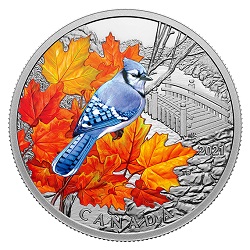
Face value: $20 dollars … Composition: 99.99% pure silver;
Mintage: 7,500; Finish: proof; Weight: 31.39 g;
Diameter: 38 mm; Edge: serrated; Certificate: serialized;
Artist: Tony Bianco (reverse); Susanna Blunt (obverse).
Design: The reverse design by Canadian artist Tony Bianco features an elevated view of an engraved park setting, where a stone path leads to a footbridge. In the foreground, the blue, black and white feathers of the blue jay (Cyanocitta cristata) make it easy to spy the colourful songbird perched among the red and gold sugar maple (Acer saccharum) leaves. The obverse features the effigy of Her Majesty Queen Elizabeth II by Susanna Blunt.
“Playing the rich oranges of the maple leaves against the soft blues of the blue jay was a way to use a complementary colour to make the coin stand out. I’ve been painting birds throughout my 35-year career as an artist, and a lot of my interest comes from time spent banding birds for scientific research. It was a great way to learn about the characteristics and beauty of these fascinating creatures.” – Tony Bianco: Artist.
Did you know? Cyanocitta cristata means the “crested, blue chattering bird.”
*** The blue feather colour isn’t due to any blue pigmentation—in fact, the feathers contain melanin, a brown pigment. The colour effect is caused by air pockets within the feather barbs that scatter visible light: while other wavelengths are absorbed by the melanin, only the blue light is refracted and it creates the perception of a blue-coloured feather. The proof: if you crush or backlight a blue jay feather, the blue disappears.
*** Black feather markings vary between individual blue jays, which may help them recognize one another. A smart and highly adaptable bird, the blue jay has a variety of calls ranging from its namesake “jay” to a call that mimics hawks. One of its strangest behaviours is anting, where it rubs ants on its feathers to possibly eliminate parasites or render them less toxic before eating.

2021 … $200 Pure Gold Piedfort – Maple Leaf Celebration
www.mint.ca www.canadapost.ca
For generations, Canada’s arboreal emblem has been engraved on many of our coins, and it has come to be associated with minting firsts and milestones—including our first gold piedfort coin in 2010. Now, for 2021, the 2010 piedfort’s maple leaf makes its distinguished return on this prestigious collectable, which honours the past while simultaneously blazing a trail as our very first 1 oz. pure gold piedfort coin.

Face value: $200 dollars … Composition: 99.99% pure gold;
Mintage: 500; Finish: modified reverse proof; Weight: 31.16 g;
Diameter: 25 mm; Edge: serrated; Certificate: serialized;
Artist: Royal Canadian Mint engravers (reverse);
Susanna Blunt (obverse).
Design: A spectacular maple celebration, your piedfort coin’s reverse features a classically rendered leaf from a red maple (Acer rubrum) tree. Along with the word “CANADA”, the gold purity standard of “9999” and the year “2021”, the reverse includes a maple leaf privy mark denoting the 25th anniversary of Canada’s national arboreal emblem, the maple tree (Acer). Enhanced by the coin’s reverse proof finish, a maple leaf field pattern dazzles on both the reverse and the obverse, which features the effigy of Her Majesty Queen Elizabeth II by Susanna Blunt.
Did you know? … *** This coin’s engraved maple leaf previously appeared on our 2010 Gold (1/5 oz.) and Silver (1 oz.) Maple Leaf Piedfort Coins. … *** Acer rubrum is one of the most commonly found maples in eastern Canada. Contrary to popular belief, the red maple wasn’t named for its fall colours (red, but sometimes gold)—it gets its name from the colour of its twigs, buds and flowers in the spring.

2021 … $5 Pure Silver Coin – Moments to Hold:
100th Anniversary of Canada’s National Colours
www.mint.ca www.canadapost.ca
This year marks the 100th anniversary of Canada’s national colours, red and white, and what better way to celebrate these than with an extraordinary flag display. From sporting events to the sea of red and white that flows through the streets on Canada Day, our national colours and flag are how we show our patriotism and national pride. And on the fourth and final coin in our 2021 Moments to Hold series, the red and white help us to shout it from the highest mountain: we are Canadian and we are proud of our home! The big finale: our 2021 Moments to Hold series ends with a red-and-white celebration of Canada.
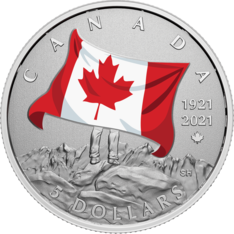
Face value: $5 dollars … Composition: 99.99% pure silver;
Mintage: 100,000; Finish: modified specimen;
Weight: 7.96 g; Diameter: 27 mm; Edge: serrated;
Artist: Steve Hepburn (reverse);
Susanna Blunt (obverse).
Design: Designed by Canadian artist Steve Hepburn, your coin’s reverse is double-dated (“1921 2021”) to mark the 100th anniversary of Canada’s national colours. Its selectively coloured image is an extraordinary display of patriotism: a Canadian proudly holds up the red-and-white flag of Canada as they shout their love of country from the highest mountain. The obverse features the effigy of Her Majesty Queen Elizabeth II by Susanna Blunt.
“The Canadian flag’s bold colours and stylized maple leaf are easily recognized the world over and have come to represent qualities like kindness, tolerance and diversity. We have a deep sense of pride for our country, and it is easy to see when we’re travelling the world or cheering on our beloved sports teams and athletes.” – Steve Hepburn, Artist.
“I am proud to say I’m Canadian, and I’m proud of the contributions we’ve made and continue to make on a national and global scale. For these reasons and more, this image gives me goosebumps! – Libby Sim, Product Manager.
“Based on suggestions dating back to 1895/96 and 1919, respectfully, both the maple leaf and our national colours of red and white (as proclaimed by King George V in 1921) were the driving force implemented by John Ross Matheson in his oversight of the final design of the National Flag of Canada. Every Canadian should be extremely proud of our red-and-white symbol, which is recognized and respected around the world.” – Robert J. Harper, Executive Director, Canadian Flag Education Centre.
Did you know? *** The red-and-white “Maple Leaf” flag has been the National Flag of Canada since 1965. In the words of John Ross Matheson, M.P. and leader of the parliamentary flag committee, it took “many loving hands” to finalize the flag’s design, which was inspired by Canada’s national colours. *** There are over 500,000 shades of red but only one appears on Canada’s flag. The exact colour value was recommended by a team of scientists at the National Research Council of Canada (NRC), who tested and analyzed different fabric dyes before determining the most durable shade of red. This was the first time that international colour standards were applied to a national flag—a world first that happened in Canada!

2021 … 1$ Pure Silver Coin –
The Quintessential Voyageur Dollar
www.mint.ca www.canadapost.ca
The quintessential Canadian collector coin has been renewed, honouring yesterday’s artistry and today’s engraving techniques. Crafted in 99.99% pure silver, this kilo coin pays tribute to both the Voyageur Dollar and its artist, Emanuel Hahn. His nostalgic image of Canada is given a place of honour on this stunning coin. But instead of re-creating the design previously featured on Canadian dollar coins (1935-1986), we went back to Hahn’s concept drawings to bring his artistic vision to life, with all its nuanced details, and on a much larger fine silver canvas than he could have ever imagined.
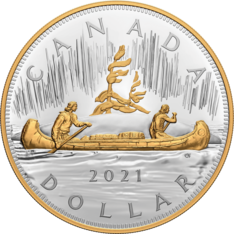
Face value: $1 dollar … Composition: 99.99% pure silver
with selective gold; Mintage: 400; Finish: proof; Weight: 1,006 g;
Diameter: 102.1 mm; Edge: serrated; Certificate: serialized;
Artist: Emanuel Hahn (reverse); Sir E. B. MacKennal (obverse).
Design: Your coin’s reverse features an early version of Emanuel Hahn’s Voyageur design, which appeared on Canadian dollar coins issued between 1935 and 1986. It is based on an original pencil sketch that is part of the National Currency Collection of the Bank of Canada Museum, located in Ottawa, Ontario. Beneath the aurora borealis, a voyageur and an Indigenous guide paddle a fur-laden canoe past wind-swept pines that rise up from a semi-circular island. The obverse pays tribute to the 85th anniversary of the last issue year (1936) of Sir E.B. MacKennal’s portrait of King George V; this effigy appeared on Canadian coins from 1911 to 1936, with the 1935 silver dollar being the only exception. The portrait is surrounded with the Latin legend, “GEORGIVS V REX IMPERATOR ANNO REGNI XXV” (George V, King and Emperor, 25th Year of Reign), honouring the first Voyageur Dollar issued in 1935 to commemorate the Silver Jubilee of King George V. Your coin comes with a special insert card featuring a reproduction of Emanuel Hahn’s original sketch, which is held at the Bank of Canada Museum.
Did you know? *** The aurora borealis didn’t appear in one of Emanuel Hahn’s preliminary sketches. And when you look at this coin, you’ll notice the aurora borealis is much more detailed in this design concept than the one that ultimately appeared on Canadian dollar coins issued between 1935 and 1986. *** Hahn’s wife, Elizabeth Wyn Wood, is also a renowned Canadian sculptor. Her modernist landscape sculptures inspired the island and wind-swept pines seen in Hahn’s Voyageur design.

2021 … Commemorative Collector Keepsake –
125th Anniversary of the Klondike Gold Rush
www.mint.ca www.canadapost.ca
Five denominations of Canadian coins are represented in this set, which includes two versions of the Klondike-themed $1 coin, plus five classic circulation pieces: $2, $1, 25-cent,10-cent and 5-cent coins (one of each). Designed by Canadian artist Jori van der Linde, the $1 coin’s reverse features the artist’s rendition of the gold discovery that set off the Klondike Gold Rush. Under the shining sun, Keish (“Skookum” Jim Mason), Shaaw Tlàa (Kate Carmack), Kàa Goox (Dawson Charlie), all of whom were of Lingít and Tagish descent, and George Carmack can be seen panning for gold at the edge of Gàh Dek (Rabbit Creek/Bonanza Creek). A powerful symbol of cultural revitalization, the pictorial symbol for Ëdhä Dädhëchą (Moosehide Slide) is highlighted in red and white on selectively coloured coins; it appears on the opposite side of the creek and represents the Tr’ondëk Hwëch’in and their deep, abiding connection to the land. The obverse features the effigy of Her Majesty Queen Elizabeth II by Susanna Blunt.

On August 16, 1896, four people made a gold discovery that captured the world’s attention. Their find triggered the Klondike Gold Rush and brought an influx of gold rushers, forever changing the land, its people and their traditional ways of living, in a manner that continues to be felt today. Mintage 100,000 RCM Item Number 201721 Artist Jori van der Linde ($1 commemorative circulation coin) Finish Circulation Composition Base metal Diameter 26.5 mm ($1 commemorative circulation coin) Weight Various.

2022 … Lenticular Coin – CP Holiday Train
www.mint.ca www.canadapost.ca
It’s a magical moment that many look forward to each year—the moment the CP Holiday Train comes rolling in! This lenticular coin captures the thrill of an annual tradition that raises spirits and raises funds to help those in need. Decked out in colourful lights and festive decorations, the CP Holiday Train is greeted by smiling crowds at every stop, where music and community spirit come together for a whistle-stop concert that benefits local food banks— even when the show must go online.
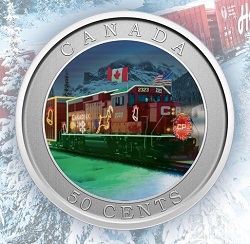
Face value: 50 Cents … Composition: nickel-plated steel;
Mintage: 100,000; Finish: modified specimen; Weight: 12.3 g;
Diameter: 35 mm; Edge: plain; Artist: Royal Canadian
Mint engravers (reverse); Susanna Blunt (obverse).
Design: The reverse design features lenticular technology that fuses two colour images and provides a smooth, seamless transition whenever the coin is tilted. The first image shows the CP Holiday Train in daylight and provides a view of the festively decorated locomotive as it journeys across Canada. The second image offers a nighttime view that captures the excitement of seeing the train pull into a community, its locomotive and cars lit up by hundreds of thousands of lights. The obverse features the effigy of Her Majesty Queen Elizabeth II by Susanna Blunt.

About the CP Holiday Train … The CP Holiday Train has been an annual holiday fundraising tradition since 1999. Each November and December, the brightly decorated trains (there are two of them) can be seen travelling along with the mainline across Canada and the United States, with scheduled stops in 150 communities. Each train is equipped with a modified boxcar that serves as a stage at each stop, where a star-studded concert entertains the crowd while volunteers collect money and food donations for the local food bank. It’s a magical experience that embodies the spirit of the giving season—to date, more than 4.8 million pounds of food donations and $19.05 million have been raised through the CP Holiday Train program, and its effects ripple through the entire year.
“I am very excited to have collaborated with Canadian Pacific Railway Company on this project. I have experienced this festive tradition with my family at stops in Smith Falls, Ont. and Merrickville, Ont.. Watching the train approach, being able to help those in need and attending a live concert all at once is a magical experience, and I hope everyone enjoys this special keepsake.” – Alicia Cook Sapene, Product Manager.
“Since 1999, the CP Holiday Train program has helped raise funds and donations for food banks throughout North America. Every year, this beautifully illuminated train makes its way across Canada and the U.S., visiting communities along with our network and bringing people together to celebrate the holidays and the spirit of giving. We love being a part of these communities as they come together, and we are proud to support local food banks along the way. CP is honoured that the Royal Canadian Mint is featuring the Holiday Train and, in doing so, helping to raise awareness of food insecurity across Canada.”– Keith Creel, Canadian Pacific President and CEO.
Did you know? … *** A favourite of train enthusiasts, the CP Holiday Train stays lit up throughout its cross-country journey so that it can be seen and enjoyed wherever it goes. Many follow its route so they can join in the celebrations at multiple stops!
*** The schedule and performer lineup change annually—you’ll find the 2021 schedule here—and the CP Holiday Train tries to visit new communities each year. In 2020, the COVID-19 pandemic prevented the train from making its annual trek, but food banks still benefitted from CP’s $1.24 million donation and funds raised during a virtual concert.


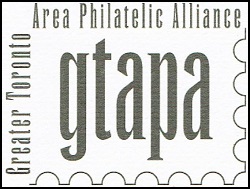
www.gtapa.org
The GTAPA is committed to promoting and stimulating
the art of philately to all ages for fun,
culture, education and friendship.


CAPEX 22
www.capex22.org
CAPEX 22 International One Frame Stamp Championship Exhibition will be held June 9-12, 2022 at the Metro Toronto Convention Centre (MTCC) in the heart of Toronto’s downtown entertainment district. With 400+ frames, CAPEX 22 will be the largest showing of one-frame exhibits at any exhibition, ever.

The exhibition will also have a wonderful array of philatelic literature exhibits both in traditional print format and with four categories of digital literature including philatelic websites. The exhibition’s bourse area will consist of more than 75 Canadian and International dealers, providing a full range of philatelic material for exhibition attendees. CAPEX 22 is being held under the patronage of the Federacion Interamericana de Filatelia (FIAF) and with the recognition of Federation Internationale de Philatélie (FIP).
Exhibition attendees may attend special seminars and other specialist society presentations of interest throughout the four days. Maresch will hold a major auction during the exhibition. The NTSC has booked a meeting room for a presentation during CAPEX 22, and we will share the details closer to the show. Collectors may choose to pre-register for the full four days; daily admissions will also be made available. Registration program information will soon be announced.




